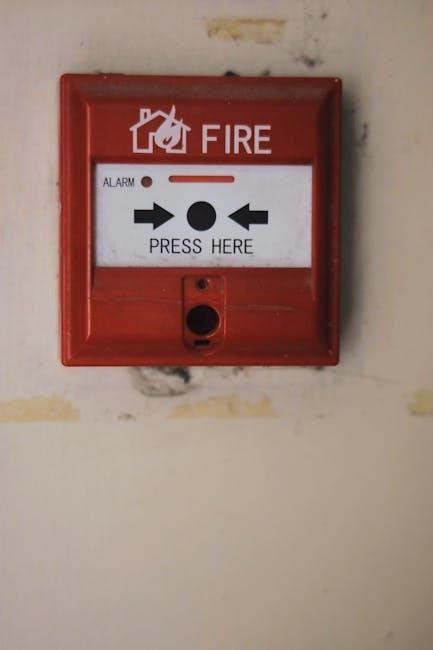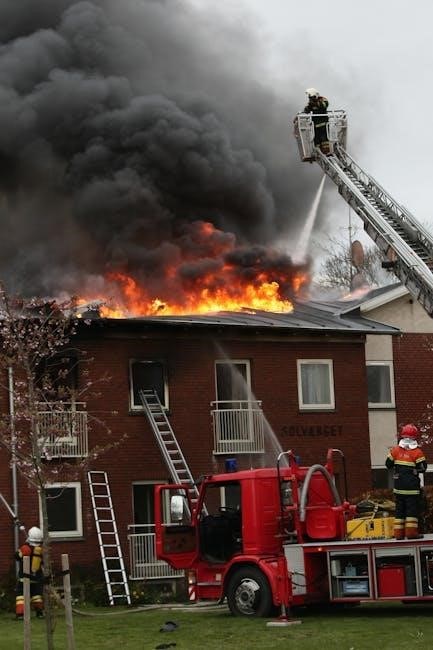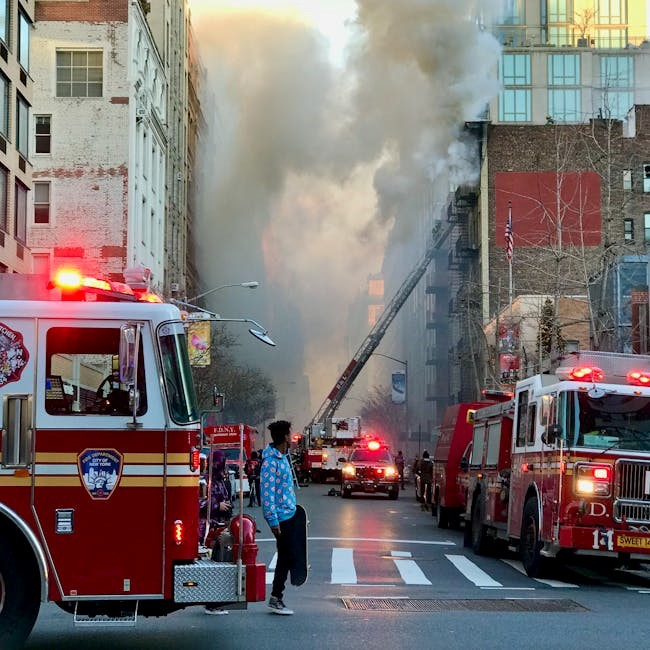Welcome to the First Alert Smoke Alarm manual. This guide provides essential information for installation, operation, and maintenance to ensure your safety and compliance with regulations.
1.1 Importance of the Manual
The First Alert Smoke Alarm manual is crucial for ensuring proper installation, operation, and maintenance. It provides vital safety information, helping you understand alarm functionality and compliance with regulations like UL217. Reading this manual ensures your smoke alarm operates effectively, safeguarding your family from potential fires. It also guides you through troubleshooting and maintenance, maximizing protection and longevity. Follow the instructions carefully to avoid false alarms and ensure the device works when needed most. Your safety depends on correct usage, making this manual an essential resource for home fire preparedness.
1.2 Key Safety Considerations
Your safety is paramount. Always follow these guidelines: Install smoke alarms on every level of your home and inside sleeping areas. Test alarms weekly and replace batteries annually. Avoid installing near vents or cooking areas to minimize false alarms. Never disable a smoke alarm; instead, use the silence button if needed. Understand the alarm’s limitations—it detects smoke, not gas, heat, or flames. Regular maintenance ensures reliability. Stay informed about expiration dates and replacement schedules. Proper usage enhances your family’s protection and compliance with safety standards like UL217.

Components of the First Alert Smoke Alarm
The First Alert Smoke Alarm includes a mounting bracket, battery drawer, test/silence button, and LED indicators. It features a photoelectric or ionization sensor for smoke detection.
2.1 Parts of the Smoke Alarm
The First Alert Smoke Alarm consists of a mounting bracket, smoke chamber, test/silence button, and LED indicators. It also includes a battery compartment and a sensor chamber. The mounting bracket secures the alarm to the ceiling or wall, while the smoke chamber houses the sensing technology. The test/silence button allows you to check functionality or mute false alarms. LED indicators provide visual alerts for smoke detection or low battery. The battery compartment holds the 9V battery, ensuring continuous operation during power outages. The sensor chamber contains either an ionization or photoelectric sensor, designed to detect smoke particles efficiently.
2.2 Included Accessories
The First Alert Smoke Alarm comes with essential accessories to ensure proper installation and functionality. These include a mounting bracket, screws, and wall anchors for secure placement. A 9V battery is provided for power backup during outages. The package also contains a user manual, detailing installation, testing, and maintenance instructions. Some models may include additional features like a tamper-resistant battery compartment or optional interconnection cables for linking multiple alarms. These accessories ensure the alarm operates effectively and integrates seamlessly into your home safety system. Proper use of all included items is crucial for optimal performance and safety.
2.3 Optional Features
Optional features enhance the functionality of your First Alert Smoke Alarm. Some models offer smart integration, allowing connection to compatible systems for remote monitoring. Voice alerts provide clear notifications, while Wi-Fi connectivity enables smartphone app control. Certain units include a 10-year battery for extended use. Additional features like interconnection capabilities ensure all alarms in the home activate together. These optional enhancements improve safety and convenience, offering advanced protection for your household. They are designed to integrate seamlessly with the base unit, upgrading your smoke alarm system to meet specific needs and preferences.

Installation Instructions
This section guides you through installing your First Alert Smoke Alarm. Choose a location, mount the bracket, and follow step-by-step instructions for secure installation. Ensure proper placement and follow safety standards for optimal functionality.
3.1 Choosing the Right Location
Proper placement of your First Alert Smoke Alarm is crucial for effective fire detection. Install alarms on every level of your home and inside each sleeping area. Avoid areas near kitchens or bathrooms to minimize false alarms caused by cooking smoke or steam. Opt for a location at least 10 feet away from cooking appliances and 3 feet from air vents. Ensure the alarm is positioned on a flat ceiling or wall, not near corners or obstructions. Follow local fire codes and manufacturer guidelines for optimal coverage and compliance. This ensures your smoke alarm operates efficiently and provides early warnings in case of fire.
3.2 Step-by-Step Installation Guide
Begin by removing the smoke alarm from the mounting bracket. Attach the bracket to the ceiling or wall using screws or adhesive strips provided. Ensure the surface is clean and dry for a secure fit. Next, insert the 9V battery into the battery compartment, following the polarity markings. Reattach the smoke alarm to the bracket by aligning the slots and turning clockwise until it clicks. Tighten the bracket using a small tool if necessary. Finally, test the alarm by pressing the test/silence button to ensure it functions properly. Refer to local fire codes for compliance.
3.3 Mounting the Bracket
Locate the ideal spot for the bracket, typically on the ceiling or wall, ensuring compliance with local fire codes. Clean the area to remove dirt or grease. Peel the backing off the adhesive strip and press the bracket firmly against the surface. If using screws, drill pilot holes and secure the bracket tightly. Ensure the bracket is level to prevent improper alarm function. For SA700LL models, use the tool provided to push and turn the alarm clockwise until it locks into place. Verify the bracket is stable to support the smoke alarm effectively.

Testing and Maintenance
Regular testing and maintenance are crucial for optimal performance. Test the alarm weekly, clean monthly, and replace batteries annually to ensure reliable smoke detection and safety.
4.1 Weekly Testing
Weekly testing ensures your smoke alarm is functioning properly. Press and hold the test button until the alarm sounds. This verifies the sensor and audible features are working. If the alarm does not sound, check the battery or connections. Regular testing helps prevent false alarms and ensures early detection of potential fires. For interconnected systems, testing one alarm will trigger all connected units. Always test during the same time weekly for consistency and reliability. A functioning smoke alarm is critical for your safety, so never skip this essential step.
4.2 Monthly Cleaning
Regular cleaning ensures optimal performance of your smoke alarm. Use a soft, dry cloth or vacuum cleaner to gently remove dust and debris from the exterior and vents. Avoid using harsh chemicals, water, or wet cloths, as they may damage the sensor. Cleaning helps prevent false alarms caused by dust buildup and maintains sensitivity to smoke. For battery-powered models, ensure the battery compartment is free from dirt. Cleaning should be done carefully to avoid pushing debris into the sensor. Consistent maintenance ensures your smoke alarm remains reliable and ready to alert you in case of a fire.
4.3 Annual Battery Replacement
Replace the 9V battery annually or when the low-battery chirp sounds. Open the battery compartment, remove the old battery, and insert a new one, ensuring proper alignment. Avoid mixing old and new batteries. After replacement, test the alarm to confirm it’s functioning correctly. For hardwired models, check the backup battery. Regular battery replacement ensures continuous protection and prevents false alarms due to low power. Dispose of old batteries responsibly. This maintenance step is crucial for the reliability and effectiveness of your smoke alarm in detecting potential fires.
4.4 Smoke Alarm Replacement Schedule
Replace your First Alert Smoke Alarm every 10 years or as specified by the manufacturer. Hardwired alarms should be replaced when they exceed their lifespan, while battery-powered units may need earlier replacement. Look for signs like frequent false alarms, physical damage, or dimming LED lights, which indicate the need for a new alarm. Properly dispose of the old unit to avoid environmental harm. Always install a new alarm meeting current safety standards, ensuring continuous protection for your home and family. This schedule helps maintain reliability and compliance with fire safety regulations.

Understanding Alerts and Indicators
Understand the different types of alerts, such as fire or carbon monoxide detection, and LED indicators for power, errors, or low battery. This helps you respond appropriately and maintain your safety system effectively.
5.1 Types of Alerts
The First Alert Smoke Alarm emits distinct alerts for different situations. A loud, continuous beep indicates fire or smoke detection, while a chirp signals low battery. Error conditions may trigger unique patterns, and some models include voice alerts for specific hazards. Understanding these alerts allows you to respond appropriately, ensuring safety and maintaining your alarm system effectively.
5.2 LED Indicators
The First Alert Smoke Alarm features LED indicators to provide visual status updates. A steady green LED confirms AC power connection, while a flashing green light indicates normal operation. The red LED blinks rapidly during an alarm event and slowly when the alarm is in error mode. Some models include a yellow LED for battery status or interconnection issues. These indicators help users quickly identify the alarm’s condition, ensuring proper functionality and enabling timely troubleshooting for any issues that arise. This visual feedback enhances safety and simplifies maintenance routines.
5.3 What to Do During a False Alarm
If a false alarm occurs due to cooking smoke, steam, or other non-emergency conditions, remain calm and follow these steps. Press the test/silence button to temporarily mute the alarm. Open windows or use a fan to clear the air. Do not disconnect the battery or remove the alarm, as this could disable its protection. Ensure the alarm automatically resets once the air clears. If frequent false alarms occur, clean the sensor or consider relocating the alarm to reduce sensitivity. Always verify there is no real danger before silencing the alarm. Your safety is the priority. Never ignore repeated alarms without investigation. Regular maintenance, like cleaning the sensor, can help minimize false alarms. If issues persist, refer to the troubleshooting section or contact customer support. Always ensure the alarm is functioning correctly after resolving the issue. Your prompt action ensures your safety and the effectiveness of the smoke alarm system. Remember, false alarms are a minor inconvenience compared to the life-saving benefits of a functioning smoke alarm. By addressing the issue promptly, you maintain the integrity of your home’s safety system and prevent potential hazards from going undetected. Never compromise on safety by disabling the alarm permanently. Stay vigilant and proactive in maintaining your smoke alarm’s performance. Regular checks and maintenance are key to avoiding unnecessary disruptions while ensuring continuous protection. Your diligence in handling false alarms contributes to a safer living environment for everyone. Always prioritize safety and adhere to the manufacturer’s guidelines for optimal performance. The First Alert Smoke Alarm is designed to protect you, and proper handling of false alarms ensures it continues to serve its purpose effectively. By following these steps, you can minimize false alarms and maintain peace of mind knowing your home is protected. If you are unsure about any aspect of handling false alarms, consult the user manual or seek professional advice to ensure your safety. Remember, your safety is paramount, and the First Alert Smoke Alarm is a trusted companion in safeguarding your home and loved ones. Always stay informed and prepared to respond appropriately during any alarm situation. The guidelines provided are designed to help you navigate false alarms with confidence and efficiency, ensuring your home remains a safe haven. By understanding and implementing these steps, you can enjoy the benefits of a reliable smoke alarm system without unnecessary interruptions. Stay safe and proactive with your First Alert Smoke Alarm.

Interconnection Features
Interconnection allows multiple First Alert Smoke Alarms to work together, ensuring all alarms sound when one detects smoke, providing enhanced safety and whole-house coverage.
6.1 How Interconnected Alarms Work
Interconnected First Alert Smoke Alarms communicate through a wired or wireless network. When one alarm detects smoke, it sends a signal to all connected units, triggering simultaneous alerts. This ensures every area of the home is notified, improving response time. Wired systems use a direct electrical connection, while wireless models rely on radio frequencies. Both methods provide reliable synchronization, ensuring maximum safety and compliance with safety standards. This feature is especially crucial in larger homes or multi-level residences, where a fire in one area may not be immediately noticeable elsewhere. Proper installation and synchronization are essential for optimal performance. Always follow the manufacturer’s guidelines to ensure all alarms function seamlessly together, providing a unified safety network for your household. This interconnected system enhances overall protection by ensuring no alarm is isolated, thereby increasing the chances of early detection and evacuation. Regular testing of the interconnect feature is recommended to maintain reliability and effectiveness. By integrating multiple alarms, you create a comprehensive safety system that offers peace of mind and robust protection against potential threats. The interconnected design is a key advancement in smoke alarm technology, addressing the limitations of standalone units and offering a more holistic approach to home safety.
6.2 Synchronizing Multiple Alarms
Synchronizing First Alert Smoke Alarms ensures all units respond simultaneously. To synchronize, press and hold the test button on one alarm until it chirps, then repeat on others within 5 seconds. This creates a unified system where all alarms sound together. Wired systems automatically synchronize, while wireless models require this manual step. Proper synchronization ensures consistent alerts throughout your home, maximizing safety. Always test synchronization after installation or battery replacement to confirm functionality. This feature is vital for whole-home protection, ensuring no area is left unalerted during a potential threat. Regular testing guarantees reliability and seamless operation.

Advanced Features
Explore smart integration and voice alerts for enhanced safety. These features offer seamless connectivity and clear notifications, upgrading your home’s protection system for a smarter home.
7.1 Smart Integration
The First Alert Smoke Alarm integrates seamlessly with smart home systems, offering enhanced safety features. By connecting to the Onelink app, users can receive real-time notifications for alerts, test their alarms remotely, and monitor system status. This integration ensures that you stay informed and protected, whether at home or away. The smart features also enable voice alerts through compatible devices, providing clear and immediate warnings in case of an emergency. This advanced connectivity elevates your home safety system, offering peace of mind and greater control over your smoke alarm’s functionality.
7.2 Voice Alerts
The First Alert Smoke Alarm features voice alerts, enhancing safety by providing clear and audible warnings. In the event of smoke detection, the alarm announces “Fire” or “Warning” to quickly alert occupants. This feature is particularly beneficial for households with children or individuals who may not easily recognize standard alarm tones. The voice alerts are loud and clear, ensuring immediate attention and prompt action. This advanced feature complements traditional tones, offering an additional layer of safety and communication during emergencies.

Troubleshooting Common Issues
Identify and resolve common problems like sensor obstructions or power issues. Ensure proper installation and maintenance to avoid false alarms and connectivity problems in interconnected systems.
8.1 Frequent Problems and Solutions
Address common issues like false alarms, connectivity problems, or sensor malfunctions. Check for dust or debris in the sensor and clean it regularly. Ensure batteries are fresh and properly installed. For hardwired models, verify power connections. Reset the alarm by disconnecting power or removing the battery for 30 seconds. If interconnected, ensure all alarms are synchronized. Test the alarm weekly to confirm functionality. Replace sensors every 10 years or as indicated. Consult the manual or contact support for persistent issues to maintain optimal performance and safety.
8.2 Resetting the Alarm
To reset your First Alert Smoke Alarm, follow these steps. For battery-powered models, remove the battery, wait 30 seconds, and reinstall it. For hardwired alarms, turn off the power at the circuit breaker, wait 30 seconds, and restore power. Press and hold the test/silence button for 10 seconds to reset. Some models automatically reset after 10 minutes. Ensure no smoke or debris triggers the sensor during the reset. After resetting, test the alarm by pressing the test button to confirm proper function. Regular resets help maintain reliability and safety.

Regulatory Compliance
First Alert Smoke Alarms meet UL217 standards and comply with local fire codes, ensuring reliable detection of combustion particles for your safety and legal requirements.
9.1 UL Certification
All First Alert Smoke Alarms are UL certified, meeting rigorous safety standards for smoke detection. UL certification ensures the alarms detect combustion particles effectively, providing reliable early warnings. This certification is a mark of compliance with industry regulations, guaranteeing the product’s performance and safety. Proper installation and maintenance are essential to uphold certification standards and ensure continuous protection. Always verify the UL mark on your device to confirm authenticity and reliability.
9.2 Meeting Local Fire Codes
First Alert Smoke Alarms are designed to meet or exceed local fire codes and regulations. Ensure your installation complies with specific requirements, such as alarm placement, spacing, and interconnectivity. Verify with local authorities for any additional mandates. Proper installation and maintenance, as outlined in this manual, will help ensure compliance. Regular testing and updates are crucial to maintaining adherence to safety standards. Refer to local fire codes for specific guidelines tailored to your area, ensuring your smoke alarm system provides optimal protection and meets all regulatory expectations.
Replacement Guidelines
Replace your First Alert Smoke Alarm every 10 years or as indicated by the expiration date. Check for wear, damage, or declining performance. Properly dispose of old units.
10.1 When to Replace the Alarm
Replace the First Alert Smoke Alarm every 10 years or when it shows signs of wear, such as a faulty LED, low battery signals, or reduced sensitivity. Ensure timely replacement for optimal safety and compliance with regulations.
10.2 How to Replace the Alarm
To replace the First Alert Smoke Alarm, start by turning off the power at the circuit breaker. Remove the old alarm by twisting it counterclockwise and disconnecting it from the bracket. Install the new alarm by securing it to the bracket and ensuring it is level. Connect the wires, if applicable, and test the alarm to confirm it works properly. Dispose of the old alarm responsibly, following local regulations for electronic waste. Always follow the manufacturer’s instructions for a safe and correct replacement.
10.3 Recycling the Old Alarm
Recycling your old First Alert Smoke Alarm is crucial for environmental protection. Remove the battery and dispose of it separately at an approved e-waste facility. Check local regulations for specific guidelines on recycling smoke alarms, as some may contain small amounts of radioactive material. Many retailers and municipalities offer e-waste collection events. Do not discard the alarm in regular trash, as it may harm the environment. Proper recycling ensures responsible disposal of potentially hazardous components, promoting sustainability and safety.
Warranty Information
Your First Alert Smoke Alarm is backed by a limited warranty covering defects in materials and workmanship. The warranty period varies by model, typically ranging from 5 to 10 years. For warranty claims, contact First Alert Customer Support at 1-800-323-9005. Provide proof of purchase and a detailed description of the issue. Warranty terms and conditions are outlined in this manual. Ensure compliance with all usage and maintenance guidelines to maintain warranty validity. Replacement or repair will be provided at First Alert’s discretion. For more details, visit their official website or refer to the provided documentation.
11.1 Warranty Period
Your First Alert Smoke Alarm is protected by a limited warranty, typically covering defects in materials and workmanship for a period of 5 to 10 years, depending on the model. The warranty ensures repair or replacement of defective units during this timeframe. For specific details, refer to the warranty section in this manual or visit the First Alert website. Proper installation, maintenance, and adherence to usage guidelines are essential to uphold warranty validity. Contact First Alert Customer Support at 1-800-323-9005 for assistance with warranty-related inquiries or claims.
11.2 Terms and Conditions
The warranty is subject to specific terms and conditions, including proper installation, regular maintenance, and adherence to usage guidelines outlined in this manual. Damage caused by misuse, tampering, or failure to follow instructions may void the warranty. The warranty does not cover normal wear and tear or batteries. For full details, review the warranty section or contact First Alert Customer Support at 1-800-323-9005. Ensure compliance with all safety standards and local regulations to maintain warranty validity and ensure optimal performance of your smoke alarm.
11.3 Filing a Warranty Claim
To file a warranty claim, contact First Alert Customer Support at 1-800-323-9005 or visit their website for online assistance. Provide proof of purchase, model number, and a detailed description of the issue. Claims must be submitted within the warranty period, and defective units may be repaired or replaced at First Alert’s discretion. Ensure all documentation is complete to avoid delays. Processing typically takes 2-4 weeks, and replacement units will meet or exceed the original specifications. For faster service, have your model number and purchase details ready when contacting support.

Additional Resources
Visit the First Alert website for downloadable manuals, video tutorials, and troubleshooting guides. Contact customer support at 1-800-323-9005 for assistance with your smoke alarm.
12.1 Downloading the Manual
To access the First Alert Smoke Alarm manual, visit the official website and search for your specific model. Manuals are available in PDF format for easy viewing and printing. Ensure you have Adobe Acrobat installed to open the files. For models like the SA4120, detailed instructions are provided to guide you through installation, testing, and maintenance. If you prefer a hard copy, contact customer support at 1-800-323-9005 for assistance. Downloading the manual ensures you have all the information needed to operate your smoke alarm effectively.
12.2 FAQs
Frequently asked questions about the First Alert Smoke Alarm include troubleshooting common issues, such as false alarms or LED indicator meanings. Users often inquire about replacement schedules and how to test the alarm. Additional questions cover interconnection features and smart app integration. For detailed answers, refer to the manual or visit the official First Alert website. Troubleshooting guides and video tutorials are also available online to address specific concerns. If unresolved, contact customer support for further assistance. This section helps users resolve common queries quickly and efficiently.
12.3 Customer Support
First Alert offers dedicated customer support to assist with any questions or concerns. For help, call 1-800-323-9005 or visit the official website. Support is available Monday through Friday, 8:00 AM to 5:00 PM CST. Representatives can address queries about installation, troubleshooting, or warranty claims. Additionally, online resources, including FAQs and user manuals, are accessible 24/7. For urgent issues, email support is also available. First Alert is committed to ensuring your safety and satisfaction with their products. If you need assistance, don’t hesitate to reach out to their knowledgeable team.
Thank you for choosing First Alert. This manual ensures your smoke alarm is used effectively, enhancing home safety. Stay vigilant and maintain your alarm for optimal protection.
13.1 Summary of Key Points
This manual outlined the importance of proper installation, testing, and maintenance of your First Alert Smoke Alarm. Regular testing, monthly cleaning, and annual battery replacement ensure optimal performance. Understanding alerts and interconnected features enhances safety. Always follow safety guidelines and replace alarms as recommended. Compliance with UL standards and local codes is crucial. By adhering to these instructions, you ensure your family’s protection. Remember, a functioning smoke alarm is a critical part of your home’s safety system, providing early warnings and saving lives. Stay informed and proactive to maintain a safe environment.
13.2 Final Safety Reminders
Always ensure your smoke alarm is functioning properly to protect your family. Never disable or remove batteries except for replacement. Test your alarm weekly and clean it monthly to maintain sensitivity. Replace batteries annually and the entire unit every 10 years. Keep alarms away from cooking areas to minimize false alerts. Develop a fire escape plan and practice it regularly. Stay informed about local fire codes and UL certifications. Remember, a working smoke alarm is your first line of defense against fire hazards. Stay vigilant and proactive to ensure your home remains safe and secure.

Leave a Reply
You must be logged in to post a comment.